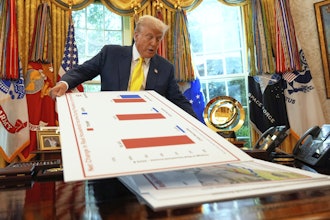
WASHINGTON (AP) — With inflation edging closer to the Federal Reserve's 2% target, its policymakers are facing — and in some cases fueling — hopes that they will make a decisive shift in policy and cut interest rates next year, possibly as soon as spring.
Such a move would reduce borrowing costs across the economy, making mortgages, auto loans and business borrowing less expensive. Stock prices could rise, too, though share prices have already risen in expectation of cuts, potentially limiting any further rise.
Fed Chair Jerome Powell, though, has recently downplayed the idea that rate reductions are nearing. With the central bank poised to keep its key short-term rate unchanged when it meets this week, Powell hasn't yet signaled that the Fed is conclusively done with its hikes. Speaking recently at Spelman College in Atlanta, the Fed chair cautioned that "it would be premature to conclude with confidence" that the Fed has raised its benchmark rate high enough to fully defeat inflation.
But the Fed's two-day meeting that ends Wednesday will mark the third straight time that its officials have kept their key rate unchanged, lending weight to the widespread assumption that rate hikes are over.
The economy, after all, is headed in the direction the Fed wants: On Tuesday, when the government releases the November inflation report, it's expected to show that annual consumer price increases slowed to 3.1%, according to a survey of economists by FactSet, down sharply from a peak of 9.1% in June 2022.
And job openings have declined, which means companies are less desperate to hire and feel less pressure to sharply raise wages, which can accelerate inflation. Consumers are still spending, though more modestly, and the economy is still expanding.
Such trends suggest progress toward what economists call a "soft landing," in which inflation reaches the Fed's 2% target without causing a recession. Analysts are increasingly encouraged by what they say is an unusually smooth adjustment to lower inflation.
That sunnier outlook represents a shift in thinking. Last year, many economists had insisted that defeating inflation would require a sharp recession and high unemployment. In fact, falling inflation, without an accompanying recession or job losses, is "historically unprecedented," economists at Goldman Sachs wrote in a recent note.
Austan Goolsbee, president of the Federal Reserve Bank of Chicago, said in an interview with The Associated Press last month that the United States is on track this year for the fastest annual drop in inflation on record. If so, Goolsbee said, the result could be a "bigger soft landing than conventional wisdom believes has ever been possible."
That said, a soft landing is hardly a sure thing. If, for example, the Fed miscalculated and kept interest rates too high for too long, it could eventually derail the economy and tip it into a recession.
"There's more risk of a recession than a re-acceleration in inflation at these interest rates," said Julia Coronado, president of MarcoPolicy Perspectives, an economic research firm. "So ultimately, the next move is likely to be a cut because of that."
The timing of any rate cuts will depend on the health of the economy. A recession — or the threat of one — would likely prompt more, and earlier, interest rate reductions by the Fed.
Yet Friday's jobs report for November showed that businesses are still adding jobs at a healthy pace, and the unemployment rate dropped to a low 3.7% from 3.9%. Such figures suggested that the most-anticipated recession in decades is not imminent. Investors have since pushed back their expectations for the first Fed rate cut from March to May.
The Fed could cut rates this year even if the economy plows ahead, as long as inflation kept falling. A steady slowdown in price increases would have the effect of raising inflation-adjusted interest rates, thereby making borrowing costs higher than the Fed intends. Reducing rates, in this scenario, would simply keep inflation-adjusted borrowing costs from rising.
Yet economists say any rate cuts in response to lower inflation may take longer than Wall Street expects because the Fed will want to be sure inflation is in check before making such a move.
Jim Bullard, former president of the Federal Reserve Bank of St. Louis and now dean of Purdue University's business school, said that while he thinks the Fed is on track for a soft landing, the policymakers must be cautious about rate cuts.
"I don't think you want to be too early on that, because if you start the process of cutting the policy rate and then inflation goes back up, I think that could cause a lot of problems," Bullard said. Such premature cuts have been blamed for the Fed's failure to quell inflation in the 1970s.
And if job gains and economic growth remain healthy, then perhaps rate cuts aren't needed anytime soon, Bullard added.
"Why lower the policy rate if the real economy is doing just fine?" he asked. "You might as well just sit back and enjoy the disinflation."
Either way, when the Fed issues its quarterly economic projections Wednesday, they will include a forecast of where its policymakers think their key rate will be at the end of 2024. Coronado expects only two rate cuts to be penciled in — half the number that financial markets now expect.
If the Fed does cut rates twice in 2024, the first one may not occur until as late as fall. Nancy Vanden Houten, lead U.S. economist at Oxford Economics, says her firm doesn't expect the first rate cut until the third quarter of the year.
"The Fed is going to want to see a bit more progress before contemplating rate cuts," she said. "Financial markets have gotten pretty ahead of themselves in our view. We think rate hikes are done, but it's going to be many months before the Fed starts cutting rates."






















